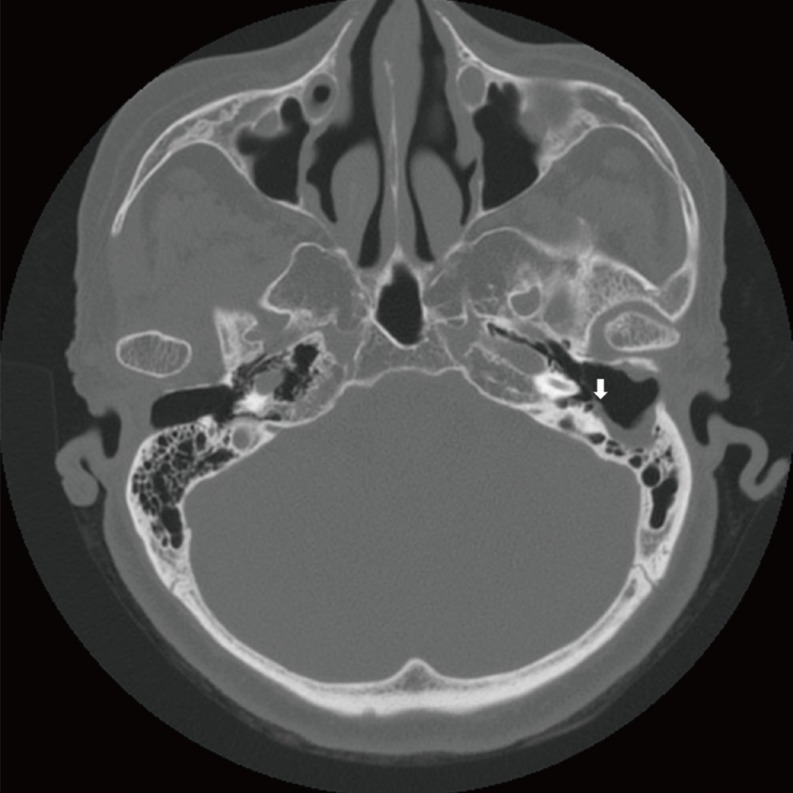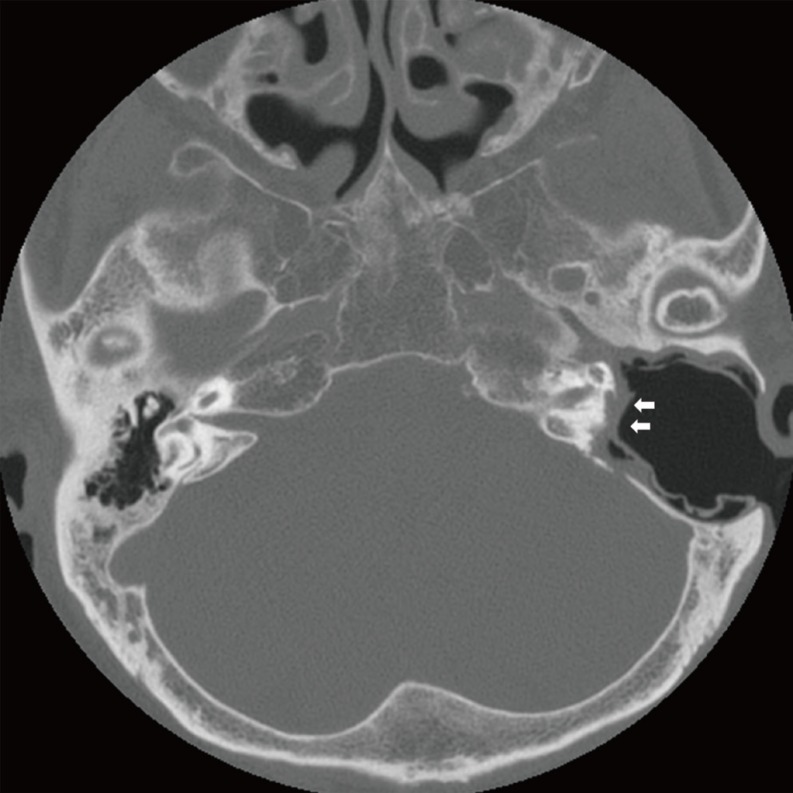Clin Exp Otorhinolaryngol.
2015 Sep;8(3):218-223. 10.3342/ceo.2015.8.3.218.
Facial Nerve Paralysis in Patients With Chronic Ear Infections: Surgical Outcomes and Radiologic Analysis
- Affiliations
-
- 1Department of Otolaryngology-Head and Neck Surgery, Chungnam National University School of Medicine, Daejeon, Korea. parkyh@cnu.ac.kr
- 2Brain Research Institute, Chungnam National University School of Medicine, Daejeon, Korea.
- KMID: 2117515
- DOI: http://doi.org/10.3342/ceo.2015.8.3.218
Abstract
OBJECTIVES
The purpose of this study was to investigate the clinical features, radiologic findings, and treatment outcomes in patients of facial nerve paralysis with chronic ear infections. And we also aimed to evaluate for radiologic sensitivities on facial canal, labyrinth and cranial fossa dehiscences in middle ear cholesteatomas.
METHODS
A total of 13 patients were enrolled in this study. Medical records were retrospectively reviewed for clinical features, radiologic findings, surgical findings, and recovery course. In addition, retrospective review of temporal bone computed tomography (CT) and operative records in 254 middle ear cholesteatoma patients were also performed.
RESULTS
Of the 13 patients, eight had cholesteatomas in the middle ear, while two patients exhibited external auditory canal cholesteatomas. Chronic suppurative otitis media, petrous apex cholesteatoma and tuberculous otitis media were also observed in some patients. The prevalence of facial paralysis in middle ear cholesteatoma patients was 3.5%. The most common involved site of the facial nerve was the tympanic segment. Labyrinthine fistulas and destruction of cranial bases were more frequently observed in facial paralysis patients than nonfacial paralysis patients. The radiologic sensitivity for facial canal dehiscence was 91%. The surgical outcomes for facial paralysis were relatively satisfactory in all patients except in two patients who had petrous apex cholesteatoma and requiring conservative management.
CONCLUSION
Facial paralyses associated with chronic ear infections were observed in more advanced lesions and the surgical outcomes for facial paralysis were relatively satisfactory. Facial canal dehiscences can be anticipated preoperatively with high resolution CTs.
Keyword
MeSH Terms
Figure
Reference
-
1. Agrawal S, Husein M, MacRae D. Complications of otitis media: an evolving state. J Otolaryngol. 2005; 6. 34(Suppl 1):S33–S39. PMID: 16089238.2. Juselius H, Kaltiokallio K. Complications of acute and chronic otitis media in the antibiotic era. Acta Otolaryngol. 1972; 12. 74(6):445–450. PMID: 4656173.
Article3. Kangsanarak J, Fooanant S, Ruckphaopunt K, Navacharoen N, Teotrakul S. Extracranial and intracranial complications of suppurative otitis media. Report of 102 cases. J Laryngol Otol. 1993; 11. 107(11):999–1004. PMID: 8288994.
Article4. Pfaltz CR. Complications of otitis media. ORL J Otorhinolaryngol Relat Spec. 1982; 44(6):301–309. PMID: 7145335.
Article5. Yorgancılar E, Yildirim M, Gun R, Bakir S, Tekin R, Gocmez C, et al. Complications of chronic suppurative otitis media: a retrospective review. Eur Arch Otorhinolaryngol. 2013; 1. 270(1):69–76. PMID: 22249835.
Article6. Savic DL, Djeric DR. Facial paralysis in chronic suppurative otitis media. Clin Otolaryngol Allied Sci. 1989; 12. 14(6):515–517. PMID: 2612031.7. Takahashi H, Nakamura H, Yui M, Mori H. Analysis of fifty cases of facial palsy due to otitis media. Arch Otorhinolaryngol. 1985; 241(2):163–168. PMID: 3977768.
Article8. Yetiser S, Tosun F, Kazkayasi M. Facial nerve paralysis due to chronic otitis media. Otol Neurotol. 2002; 7. 23(4):580–588. PMID: 12170164.
Article9. Antoli-Candela F Jr, Stewart TJ. The pathophysiology of otologic facial paralysis. Otolaryngol Clin North Am. 1974; 6. 7(2):309–330. PMID: 4599259.
Article10. Harker LA, Pignatari SS. Facial nerve paralysis secondary to chronic otitis media without cholesteatoma. Am J Otol. 1992; 7. 13(4):372–374. PMID: 1415504.11. Redaelli de Zinis LO, Gamba P, Balzanelli C. Acute otitis media and facial nerve paralysis in adults. Otol Neurotol. 2003; 1. 24(1):113–117. PMID: 12544039.
Article12. Di Martino E, Sellhaus B, Haensel J, Schlegel JG, Westhofen M, Prescher A. Fallopian canal dehiscences: a survey of clinical and anatomical findings. Eur Arch Otorhinolaryngol. 2005; 2. 262(2):120–126. PMID: 15592859.
Article13. Takahashi H, Sando I. Facial canal dehiscence: histologic study and computer reconstruction. Ann Otol Rhinol Laryngol. 1992; 11. 101(11):925–930. PMID: 1444101.
Article14. Yetiser S. The dehiscent facial nerve canal. Int J Otolaryngol. 2012; 2012:679708. PMID: 22518159.
Article15. Barnes G, Liang JN, Michaels L, Wright A, Hall S, Gleeson M. Development of the fallopian canal in humans: a morphologic and radiologic study. Otol Neurotol. 2001; 11. 22(6):931–937. PMID: 11698822.
Article16. Ikeda M, Nakazato H, Onoda K, Hirai R, Kida A. Facial nerve paralysis caused by middle ear cholesteatoma and effects of surgical intervention. Acta Otolaryngol. 2006; 1. 126(1):95–100. PMID: 16308261.
Article17. Ozbek C, Somuk T, Ciftci O, Ozdem C. Management of facial nerve paralysis in noncholesteatomatous chronic otitis media. B-ENT. 2009; 5(2):73–77. PMID: 19670593.18. Quaranta N, Cassano M, Quaranta A. Facial paralysis associated with cholesteatoma: a review of 13 cases. Otol Neurotol. 2007; 4. 28(3):405–407. PMID: 17414046.19. Chu FW, Jackler RK. Anterior epitympanic cholesteatoma with facial paralysis: a characteristic growth pattern. Laryngoscope. 1988; 3. 98(3):274–279. PMID: 3343877.20. Djeric D, Savic D. Otogenic facial paralysis: a histopathological study. Eur Arch Otorhinolaryngol. 1990; 247(3):143–146. PMID: 2350504.
- Full Text Links
- Actions
-
Cited
- CITED
-
- Close
- Share
- Similar articles
-
- Surgical Treatment of Facial Paralysis
- Facial Nerve Paralysis and Surgical Management
- Facial Nerve Paralysis due to Chronic Otitis Media: Prognosis in Restoration of Facial Function after Surgical Intervention
- Factors Contributing to the Facial Paralysis after Temporal Petrous Fractures
- A Case of Chronic Suppurative Otitis Media with Facial Nerve Palsy due to Aspergillus Infection



